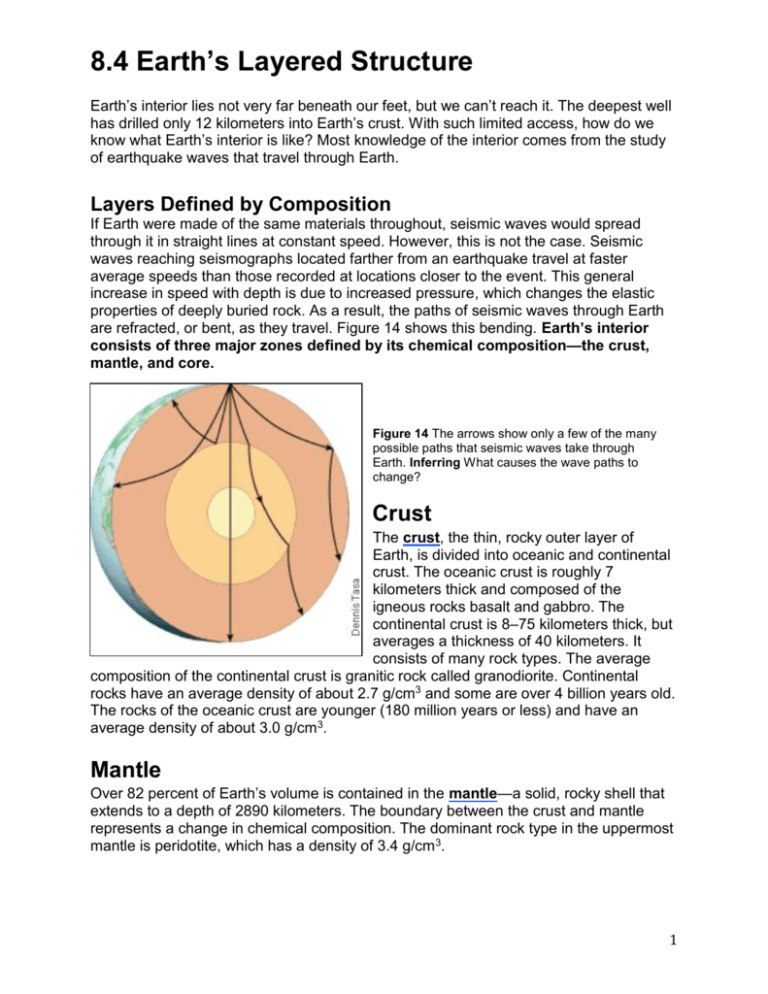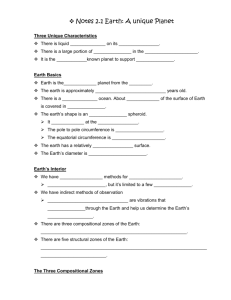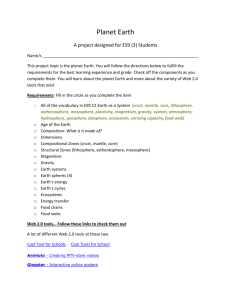8.4 Earth`s Layered Structure Reading and Qs
advertisement

8.4 Earth’s Layered Structure Earth’s interior lies not very far beneath our feet, but we can’t reach it. The deepest well has drilled only 12 kilometers into Earth’s crust. With such limited access, how do we know what Earth’s interior is like? Most knowledge of the interior comes from the study of earthquake waves that travel through Earth. Layers Defined by Composition If Earth were made of the same materials throughout, seismic waves would spread through it in straight lines at constant speed. However, this is not the case. Seismic waves reaching seismographs located farther from an earthquake travel at faster average speeds than those recorded at locations closer to the event. This general increase in speed with depth is due to increased pressure, which changes the elastic properties of deeply buried rock. As a result, the paths of seismic waves through Earth are refracted, or bent, as they travel. Figure 14 shows this bending. Earth’s interior consists of three major zones defined by its chemical composition—the crust, mantle, and core. Figure 14 The arrows show only a few of the many possible paths that seismic waves take through Earth. Inferring What causes the wave paths to change? Crust The crust, the thin, rocky outer layer of Earth, is divided into oceanic and continental crust. The oceanic crust is roughly 7 kilometers thick and composed of the igneous rocks basalt and gabbro. The continental crust is 8–75 kilometers thick, but averages a thickness of 40 kilometers. It consists of many rock types. The average composition of the continental crust is granitic rock called granodiorite. Continental rocks have an average density of about 2.7 g/cm3 and some are over 4 billion years old. The rocks of the oceanic crust are younger (180 million years or less) and have an average density of about 3.0 g/cm3. Mantle Over 82 percent of Earth’s volume is contained in the mantle—a solid, rocky shell that extends to a depth of 2890 kilometers. The boundary between the crust and mantle represents a change in chemical composition. The dominant rock type in the uppermost mantle is peridotite, which has a density of 3.4 g/cm3. 1 Core The core is a sphere composed of an iron-nickel alloy. At the extreme pressures found in the center of the core, the iron-rich material hasan average density of almost 13 g/cm3 (13 times heavier than water). Layers Defined by Physical Properties Earth’s interior has a gradual increase in temperature, pressure, and density with depth. When a substance is heated, the transfer of energy increases the vibrations of particles. If the temperature exceeds the melting point, the forces between particles are overcome and melting begins. If temperature were the only factor that determined whether a substance melted, our planet would be a molten ball covered with a thin, solid outer shell. Fortunately, pressure also increases with depth and increases rock strength. Depending on the physical environment (temperature and pressure), a material may behave like a brittle solid, a putty, or a liquid. Earth can be divided into layers based on physical properties—the lithosphere, asthenosphere, outer core, and inner core. Lithosphere and Asthenosphere Earth’s outermost layer consists of the crust and uppermost mantle and forms a relatively cool, rigid shell called the lithosphere. This layer averages about 100 kilometers in thickness. Beneath the lithosphere lies a soft, comparatively weak layer known as the asthenosphere. The asthenosphere has temperature/pressure conditions that may result in a small amount of melting. Within the asthenosphere, the rocks are close enough to their melting temperatures that they are easily deformed. Thus, the asthenosphere is weak because it is near its melting point, just as hot wax is weaker than cold wax. The lower lithosphere and asthenosphere are both part of the upper mantle. Lower Mantle From a depth of about 660 kilometers down to near the base of the mantle lies a more rigid layer called the lower mantle. Despite their strength, the rocks of the lower mantle are still very hot and capable of gradual flow. The bottom few hundred kilometers of the mantle, laying on top of the hot core, contains softer, more flowing rock like that of the asthenosphere. Inner and Outer Core The core, which is composed mostly of an iron-nickel alloy, is divided into two regions with different physical properties. The outer core is a liquid layer 2260 kilometers thick. The flow of metallic iron within this zone generates Earth’s magnetic field. The inner core is a sphere having a radius of 1220 kilometers. Despite its higher temperature, the material in the inner core is compressed into a solid state by the immense pressure. 2 Figure 15 Earth’s Layered Structure The left side of the globe shows that Earth’s interior is divided into three different layers based on compositional differences—the crust, mantle, and core. The right side of the globe shows the five main layers of Earth’s interior based on physical properties and mechanical strength—the lithosphere, asthenosphere, mesosphere, outer core, and inner core. The block diagram shows an enlarged view of the upper portion of Earth’s interior Discovering Earth’s Layers In 1909, a Croatian seismologist, Andrija Mohorovičić, presented evidence for layering within Earth. By studying seismic records, he found that the velocity of seismic waves increases abruptly below about 50 kilometers of depth. This boundary separates the crust from the underlying mantle and is known as the Mohorovičić discontinuity. The name is usually shortened to Moho. Another boundary was discovered between the mantle and outer core. Seismic waves from even small earthquakes can travel around the world. This is why a seismograph in Antarctica can record earthquakes in California or Italy. However, it was observed that P waves were bent around the liquid outer core beyond about 100 degrees away from an earthquake. The outer core also causes P waves that travel through the core to arrive several minutes later than expected. This region, where bent P waves arrive, is sometimes called the shadow zone. The bent wave paths can be explained if the core is composed of material that is different from the overlying mantle. The P waves bend around the core in a way similar to sound waves being bent around the corner of a building. For example, you can hear people talking from around the side of a building even if you cannot see them. In this way, rather than actually stopping the P waves in the shadow zone, the outer core bends them, as you can see modeled in Figure 16. It was further shown that S waves could not travel through the outer core. Therefore, geologists concluded that this region is liquid. 3 Figure 16 Earth’s Interior Showing P and S wave Paths The change in physical properties at the mantle-core boundary causes the wave paths to bend sharply. Any location more than 100 degrees from an earthquake epicenter will not receive direct S waves because the liquid outer core will not transmit them. Discovering Earth’s Composition We have examined Earth’s structure, so now let’s look at the composition of each layer. Early seismic data and drilling technology indicate that the continental crust is mostly made of lighter, granitic rocks. Until the late 1960s, scientists had only seismic evidence they could use to determine the composition of oceanic crust. The recovery of ocean-floor samples was made possible with the development of deep-sea drilling technology. The crust of the ocean floor has a basaltic composition. The composition of the rocks of the mantle and core is known from more indirect data. Some of the lava that reaches Earth’s surface comes from the partially melted asthenosphere within the mantle. In the laboratory, experiments show that partially melting the rock called peridotite produces a substance that is similar to the lava that erupts during volcanic activity of islands such as Hawaii. Surprisingly, meteorites that collide with Earth provide evidence of Earth’s inner composition. Meteorites are assumed to be composed of the original material from which Earth was formed. Their composition ranges from metallic meteorites made of iron and nickel to stony meteorites composed of dense rock similar to peridotite. Because Earth’s crust contains a smaller percentage of iron than do meteorites, geologists believe that the dense iron, and other dense metals, sank toward Earth’s center during the planet’s formation. Lighter substances may have floated to the surface, creating the less-dense crust. Earth’s core is thought to be mainly dense iron and nickel, similar to metallic meteorites. The surrounding mantle is believed to be composed of rocks similar to stony meteorites. 4 SECTION 8.4 Earth’s Layered Structure Assessment Reviewing Concepts (1) List the major layers of Earth’s internal structure based on physical properties. List the layers in order from Earth’s center to the surface. (2) What is the composition of Earth’s core? (3) What evidence indicates that Earth’s outer core is liquid? (4) What is the composition of the mantle? Critical Thinking (5) Comparing And Contrasting Compare the physical properties of the asthenosphere and the lithosphere. (6) Inferring Why are meteorites considered important clues to the composition of Earth’s interior? (7) What are “Moho lines”? SECTION 8.4 Earth’s Layered Structure Assessment Reviewing Concepts (1) List the major layers of Earth’s internal structure based on physical properties. List the layers in order from Earth’s center to the surface. (2) What is the composition of Earth’s core? (3) What evidence indicates that Earth’s outer core is liquid? (4) What is the composition of the mantle? Critical Thinking (5) Comparing And Contrasting Compare the physical properties of the asthenosphere and the lithosphere. (6) Inferring Why are meteorites considered important clues to the composition of Earth’s interior? (7) What are “Moho lines”? 5





